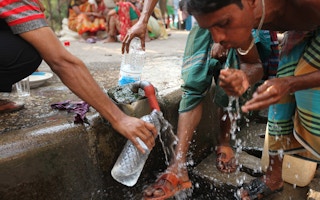World Water Day arrives, as it does every spring in the northern latitudes, with snow melt and rains feeding rivers with life-sustaining freshwater. It’s a familiar and comforting picture of renewal. With the changing season, I find myself reflecting on the past year and reasons for both alarm and hope about our global water future.
3 Reasons for worry
There are many reasons to be concerned about water resource challenges around the world, but three in particular hit with force over the past year:
Drought and food crises
The first alarm bell sounded in Africa, where multiple countries are suffering some of the worst drought-related food shortages in more than a decade, driven by one of the strongest El Niño’s on record. International aid groups project that one million children in southern and eastern Africa are suffering severe malnutrition, and 2.5 million people across southern Africa are in crisis stages of food insecurity.
While this crisis was driven by weather, it spotlights the kind of human misery that results from drought combined with often poorly managed water resources, such as inefficient irrigation practices and infiltration practices during droughts. It’s also a harbinger of disruptions that climate change will likely bring more of, particularly in parts of Latin America, Africa and Asia where poor populations are especially vulnerable.
Extreme rains and floods
The second alarm wailed over the opposite problem: too much water, falling too quickly. River floods caused $104 billion of damage in 2014, and flooding (river and coastal) made up almost half of all weather-related disasters in the last two decades, according the UNISDR. Floods are as perennial as seasons in many parts of the world, but studies clearly show that daily precipitation extremes have risen over the past 50 to 100 years—as much as 1 – 2 per cent each decade since the 1950s.
Just in the past six months, three-times-normal rains in Chennai, India killed nearly 300, while record-breaking floods in the southern United States (26 inches fell in some areas over just three days in March) led to the evacuation of 3,500 homes. WRI’s Global Flood Analyzer shows how these human and economic impacts could worsen in places around the world, depending on climate impacts, socioeconomic factors and investment in flood defenses.
The silent groundwater emergency
It’s been known for some time that we are draining the world’s aquifers faster than we can replenish them, but new analysis paints an even starker picture than many realized. Researchers at the University of California, Irvine, using data from NASA’s GRACE satellite mission, found that since 2003, water reserves in 21 of the 37 largest aquifers globally have declined. Further, more than half of the declining aquifers are depleted to the point that regional water supplies are at risk. This is a frightening prospect, as more than 2.5 billion people rely on aquifers as their primary water source, and groundwater is often the emergency reservoir for agriculture and municipal use when rivers aren’t flowing.
“
The challenges we face this World Water Day are undeniably huge. But we can’t afford to be in denial, or hand wring, or let complexity paralyze us.
3 Reasons to feel hopeful
Yet while the statistics are stark, we’re also at an unprecedented time of opportunity for better water management. New examples continue to crop up on how businesses, cities and governments are understanding the connections between water and climate, taking the right steps to capitalize on them, and beginning to scale up strategies that work. Some powerful opportunities lay before us that can help create a more water-secure future:
Aligning the Paris Agreement and SDGs
The past six months saw international adoption of two remarkable agreements: the new UN Sustainable Development Goals (SDGs) and the Paris Climate Agreement. These international commitments can actually be mutually reinforcing, if implemented well. A study by the French Water Partnership and Coalition Eau noted that 92 per cent of the 100 countries with new adaptation plans mentioned water as the top priority area. The SDG goal on water for the first time includes a target (SDG 6.4) on sustainable withdrawals and improving sectoral water use efficiency. Taken together, these are landmark opportunities for communities to become better adapted to future climate realities and meet their water needs.
In fact, better water management can actually help achieve some of the goals outlined in the new climate Agreement. Energy needed to pump, heat and treat water is enormous, with some estimates putting it at 13 per cent of U.S. electricity use, and even higher where water is moved long distances, such as in California (19 per cent of total electricity use). Having to pump water from deep underground or far away basins, or wasting water through inefficient uses and leaky pipes, takes a tremendous energy toll. Better, more efficient water management can help reduce energy use and its associated emissions.
Helping farmers produce more with less water
Globally, agriculture uses 70 per cent of all water and consumes more than any other sector. Many of the world’s poor survive on food they grow, and food they sell is vital to broader food security in many countries. In Burkina Faso, Ethiopia and elsewhere in Africa, farmers are now employing simple “regreening” strategies like allowing trees to grow on farms and harvesting rainwater in order to improve soil moisture and fertility. These farmers have increased crop yields and helped restore depleted aquifers and wells. In fact, a recent WRI working paper showed that approaches for improving land and water management on just 25 per cent of sub-Saharan Africa’s 300 million hectares of prime cropland would result in an additional 22 million tons of food.
In a much different way, Australia’s water rights allocation and trading system for the Murray Darling River basin has transformed its agricultural sector. The system allows farmers to quickly decide what to plant, or whether to sell their annual water allocations, based on market conditions. It’s helped the country’s large commercial agriculture sector trade water to higher economic value crops (e.g., wine, fruits and nuts) and incentivized more efficient irrigation and cropping practices.
Cities can lead the way
Half the global population now lives in cities, which are straining to meet the needs of growing populations and economies as they compete for scarce water resources in many areas. Yet cities are also emerging as centers of water management innovation.
Australia’s 15-year long Millennium Drought, which began in the mid-1990s, caused cities to make major investments in water-efficiency programs like installing low-flow fixtures in homes and buildings, providing audits and cost-sharing for retrofits and water recycling systems, and requiring new buildings to have systems to capture rainwater for non-potable purposes.
According to a new report that looks at lessons from the continent’s experience, South East Queensland reduced residential water demand by 60 per cent during the drought(to 33 gallons per capita per day), and has since only increased to 45 gallons per capita per day since the drought ended. These savings helped to delay or eliminate the need for expensive, new water and wastewater infrastructure to accommodate future population and economic growth.
Cities around the world are also grappling with costly, energy-intensive wastewater treatment plants—and a handful are pursuing an innovative solution. “Sludge,” or the organic matter left over from treating wastewater, can be used to produce methane, which can power treatment facilities or fuel vehicles.
Cities in Germany, China, the United States and elsewhere are experimenting with this waste-to-energy technology, but the potential for urban areas around the world is tremendous. According to the World Bank, as much as 168 terawatt hours (TWh) of energy – the equivalent of 23 large (1,000 MW) thermal electric power plants – is available in energy savings from the wastewater treatment sector each year.
The challenges we face this World Water Day are undeniably huge. But we can’t afford to be in denial, or hand wring, or let complexity paralyze us. The kind of actions described above—and many more—can and will make a measureable difference. Is there cause for worry? Of course. Is there equal reason for hope? Yes. Now is the time to seize on the clear opportunities before us and act.
Betsy Otto is director of World Resources Institute’s global water programme. This post was republished from the WRI Blog.











